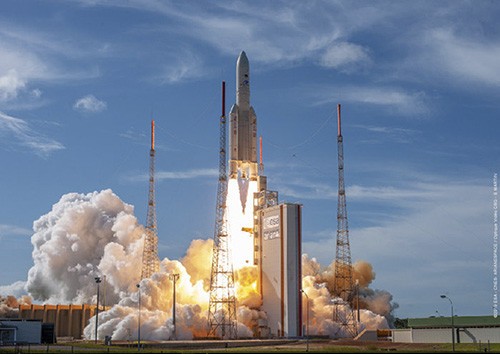Successful launch of EDRS-C, second satellite of the European Data Relay System

On August 6 EDRS-C, the second spacecraft of the EDRS infrastructure, started its journey from Kourou to its assigned geostationary slot.
The Ariane 5 vehicle and launch team performed flawlessly, injecting EDRS-C into the expected orbit. The DLR GSOC team connected to the spacecraft and started LEOP operations as planned. EDRS-C will reach its GEO slot within the next two weeks.
EDRS-C is an Airbus-owned spacecraft, equipped with a Laser Communication Terminal and Ka-band RF equipment, acting as the second GEO node of the EDRS (European Data Relay Service) infrastructure on which the Airbus SpaceDataHigway commercial-service is based.
The SpaceDataHighway is the world’s first ‘optical fiber’ network in space, based on laser technology which can transmit data at a rate of 1.8 Gbit/s.
SpaceDataHighway geostationary satellites can connect via laser link to Low Earth Orbit observation satellites at a distance up to 45,000 km and then relay observation data to Earth in near-real-time, a process that would normally take around 90 minutes.
As of today four ESA Sentinel satellites are connected to the SpaceDataHighway for sending to ground high-quality images. In 2020 Columbus (the ISS European module) will start using the service for establishing a direct datalink to Europe, bypassing the NASA Ground Segment.
Airbus is currently testing an airborne laser terminal which will also enable intelligence UAVs and aircrafts to connect via laser link to the EDRS GEO nodes.
GMV INSYEN is supporting the EDRS infrastructure with major contributions and responsibilities in the development of the EDRS-A and EDRS-C Payload control center, in the EDRS-C Spacecraft and Ground Segment Product Assurance and in the EDRS-C Spacecraft Operations.